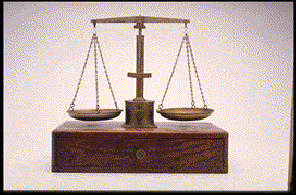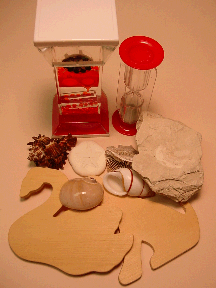BACKGROUND:
Science and mathematics use the ability to
predict or estimate to help guide the experiment or the mathematical
conclusion. These skills are learned, and with practice can increase a person’s
proficiency.
Prediction is based on prior knowledge or familiarity
with an event or substance. Predicting what it would be like in space, would
require prior experiences with flying on an airplane or riding on some
amusement park rides. If a person has not experienced a similar event,
prediction is very difficult. The more experiences a child has, the better
they will be able to predict an experience.
 Estimating is an attempt to determine an accurate
answer. For instance, if you are estimating the arrival time of an airplane
flying from San Francisco to New York, you would take the time of departure
and add about 5 hours. You would also have to take into account a 3 hour
difference in time. This information will allow you can estimate time of
arrival. An accurate answer would be considered a realistic answer. For
example, if you ask a student to estimate the number of beans in a cup and
they answer, "20 million," the answer is not accurate. Estimation
requires thinking, it is not just any answer. Estimating is an attempt to determine an accurate
answer. For instance, if you are estimating the arrival time of an airplane
flying from San Francisco to New York, you would take the time of departure
and add about 5 hours. You would also have to take into account a 3 hour
difference in time. This information will allow you can estimate time of
arrival. An accurate answer would be considered a realistic answer. For
example, if you ask a student to estimate the number of beans in a cup and
they answer, "20 million," the answer is not accurate. Estimation
requires thinking, it is not just any answer.
PROCEDURE:
Many times scientists have to predict
the outcome of their experiment in order to design the experiment.
In this lab, students will predict or estimate the volume, weight,
length, time, and taste of items without touching them. They will then determine
if their predictions are correct by going to each station and actually
doing the experiment.
- Prior to the students doing the lab, set
up materials in stations and have the students rotate to each station.
Use the enclosed labels to identify the stations. The kit contains
some of the materials for each of the stations, but these can be substituted
by other appropriate materials. Additional materials such as boxes
or household materials are needed to complete the stations. This lab my
require two lab periods especially if children have never estimated or
predicted before.
PRIOR TO THE LAB:

|
| Introduce the concepts of prediction
and estimation. Module includes 2 timers(liquid and sand), 1 piece
diatomite, 3 seashells, flower coral, and sea cookie, and 2 wood
animal cut outs. Primary balance is also needed |
At each station display the following questions
on index cards (enclosed). The cards should have the following set
up:
- VOLUME - WHICH ONE HAS THE MOST WATER?
Display two glasses, or jars, of different
shapes. Fill one with more water than the other. To demonstrate
the answer to students you can pour the contents of the jars into measuring cups
(need to provide) and measure the quantity in each container.
- WEIGHT - WHICH ONE IS LIGHTEST IN
WEIGHT?
Display the one large white rock (diatomite) (in your
kit, very light chalk),
and find something smaller but heavier. Use the primary balance to find
the answer. Try and make the lighter rock larger than the other item. You may want to discuss that
diatomite is made up of tiny fossils (diatoms) that have hole, making
the rock light (less dense) and almost fluffy.
- LENGTH - WHICH ONE IS LONGEST?
Display one abalone shell and two types of
marine snails (in kit). Provide a ruler for students to measure each
sample.
- WEIGHT - WHICH ONE WEIGHTS THE MOST?
Display a sea cookie and a flower coral (in
kit). Weigh them with the primary balance.
- LENGTH - WHICH IS LONGEST?
Display 2 animal cut outs (in kit).
Measure the width of both with a ruler. Which is widest?
- SOUR - WHICH ONE IS MOST SOUR?
Purchase 2 types of yellow candy, one sour
and one sweet (need to provide). If available, make one sugarless.
Allow students to "taste them" to get the answer.
- VOLUME - WHICH ONE HAS THE MOST WATER?
This station is similar to number 1, but
use tall and short glasses instead. Graduated cylinders are ideal (need
to provide).
- WEIGHT - WHICH ONE IS WEIGHS THE LESS?
Display two objects and have students determine which one
weighs the less by using a primary balance.
- TIME - WHICH ONE IS THE LONGEST?
Display two timers (in kit) To test
them, have students flip over both timers at the same time and determine
which takes longer to empty.
- LIQUID - WHICH ONE IS THE SLOWEST?
Display a jar of honey and another liquid
(need to provide). Make sure the lids are tightly closed. Introduce
the word viscous. Explain that viscous means thick. Turn the jars
on their sides and upside down to observe the movement of the liquids to
test the viscosity of the liquid.
- Discuss length, volume, weight (make sure
you discuss heavy and light), liquid, and sour taste.
- Explain to students that they will move from station
to station as a group looking at different things. They will have 2
to 3 minutes at each station. At each station have them predict the answer
to each question. They cannot touch anything at this time.
Explain that after everyone has made their predictions, they will be able
to "test" them.
- After everyone has made their
predictions let the students do the tests at the stations. If it
is not practical to allow the groups to do all the testing, the teacher
can demonstrate some or all of the stations. Allow up to five minutes
per station. Students should record the results of the tests in the
corresponding column on their lab sheets. Remind the students
that it does not matter if their predictions were correct or not.
Science involves learning the true answers. In science we learn from
right answers as well as wrong answers.
|